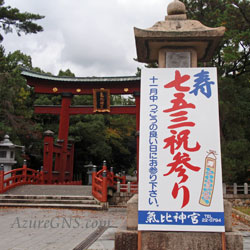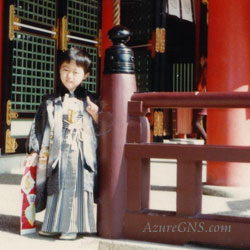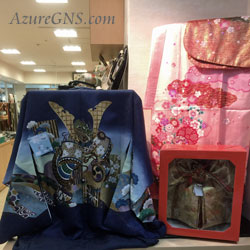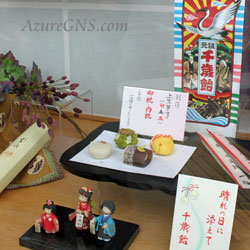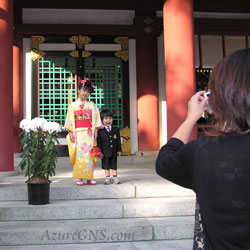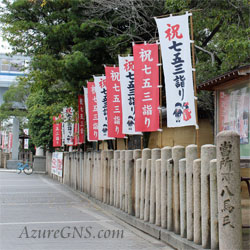(11月15日とその前後)
Shichi-Go-San;
The Seven-Five-Three Festival
(on or around November 15th)
●七五三 Shichi-Go-San; the Seven-Five-Three-Festival
●祝い celebration
●儀式 ceremony;(宗教的)ritual;(社会的・宗教的)function
●健康 health
●成長 growth
●長寿 longevity
●神社 shrine
●神主;神官 (Shinto) priest
●寺 temple
●僧侶 (Buddhist) priest
●教会 church
●神父(カトリック・正教会) priest
●牧師(プロテスタント) minister
●記念写真 memorial picture
●晴れ着 best clothes; Sunday best
●千歳飴 Chitose-ame; 1000-year candy
◆一般に七五三は7歳の女の子、5歳の男の子、3歳の男の子と女の子のお祝いです。
Shichi-Go-San (literally 7-5-3) is usually a celebration for 7-year-old girls, 5-year-old boys, and 3-year-old boys and girls.
◆日本の数秘術では奇数は縁起が良いとみなされているので、7、5、3の年齢が選ばれたと言われています。
The ages of 7, 5 and 3, said to have been chosen as odd numbers, are considered auspicious in Japanese numerology.
◆何歳の男の子と女の子がどのように祝われるかは地方によって異なります。
The age at which boys and girls participate and the way they are celebrated sometimes vary by region.
◆伝統的には女の子は美しい着物と帯を、男の子は羽織袴を着ます。
Traditionally, girls are dressed in beautiful kimono (a Japanese traditional robe-style costume) and obi (a sash), and boys are dressed in haori (a Japanese traditional half coat) and hakama (a pair of Japanese traditional skirt-like pants).
◆女の子も男の子も白足袋と草履を履きます。
Both girls and boys wear white tabi (a pair of Japanese toe-divided socks) and zori (a pair of Japanese sandals with a thong).
◆または華やかなドレスやタキシードなどのフォーマルな洋服で着飾る子供もいます。
In some cases, children are dressed up in formal western clothes such as gorgeous dresses or tuxedos.
◆11月15日、またはその前後に子供達は両親に連れられて大概地元の神社に行きます。
On or around November 15th, children are taken to shrines, usually their local ones, by their parents.
◆神主がお祓いをして、神様に子供達の名前を読み上げます。
Priests hold a Shinto purification ceremony and read out the children’s names to the gods.
◆子供達や両親はこれまでの成長と幸せを神様に感謝し、これからも見守っていただけるように祈ります。
Children and parents thank the gods for the children’s healthy and happy growth and pray for their continuous protection.
◆最近は寺院や教会でも七五三の行事が行われます。
These days, Shichi-Go-San ceremonies are held even in temples and churches.
◆子供達は1000歳の飴という意味の千歳飴をもらい喜びます。
Children are happy to receive Chitose-ame, which means 1000-year candy.
◆千歳飴は米粉と麦芽糖で作られた紅白の細長い飴です。
Chitose-ame is red and white stick candy made from rice powder and malt sugar.
◆この飴は子供達の成長と長寿の象徴として作られます。
The candy is made to represent the growth and longevity of children.
◆そして鶴、亀、松、花などの絵が描かれている、色鮮やかで縁起の良い紙の袋に入れて贈られます。
The candy is presented in colorful good luck paper bags, which are decorated with drawings of cranes, turtles, pine trees, flowers, and other illustrations.
◆千歳飴の起源は江戸時代(1603-1867)中期、浅草寺の門前で飴売りの七平衛が売り出したのが始まりと言われています。
The origin of chitose-ame is said to be the candies sold by Shichibei in front of the Senso-ji Temple in the middle of the Edo period (1603-1867).
◆子供達は記念写真やビデオを撮ってもらいます。
Memorial pictures and videos are taken of the children.
◆多くの写真店では七五三の衣装のレンタル、着付け、ヘアメーク、撮影を全てセットにして行っています。
Many photo studios offer special Shichi-Go-San packages including costume rentals, dressing, hairstyling, makeup and photography.
◆元々、厳密に言えば七五三の習慣は平安時代(794-1191)には貴族や武士階級のものでした。
Originally, the custom of Shichi-Go-San was strictly for the aristocracy and the warrior classes during the Heian period (794-1191).
◆当時、3歳の女の子は髪を伸ばし始める儀式をしました。
In those days, three-year-old girls had a ceremony to mark the beginning of them growing their hair long.
◆5歳の男の子は初めて袴を履く儀式をしました。
Five-year-old boys had a ceremony to mark their first time wearing Hakama.
◆7歳の女の子は初めて着物を帯で締める儀式をしました。
Seven-year-old girls had a ceremony to mark their first time tying a Kimono with an Obi.
◆七五三は江戸時代に徐々に町民にも広まりました。
During the Edo period, Shichi-Go-San gradually became a popular event among the townspeople as well.
◆日にちの由来は、徳川幕府の五代将軍綱吉の長男の徳松の成長を祝う儀式を11月15日に行ったことによるといわれています。
The date is said to derive from the historical fact that a ceremony was held for Tokumatsu or the first son of Tsunayoshi, the 5th Shogun of the Tokugawa clan, for his growth on November 15th.
◆明治時代(1868-1912)に現在の七五三の形として親しまれるようになりました。
The present-day customs of Shichi-Go-San became popular during the Meiji period (1868-1912).
(より詳しい情報は「我が家の七五三」をご覧下さい。)
(Please see “My Seven-Five-Three Festival Experience” for further information.)
Copyright (C) Azure Global Network Services. All Rights Reserved.
